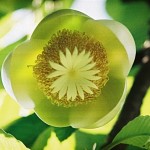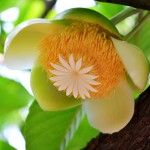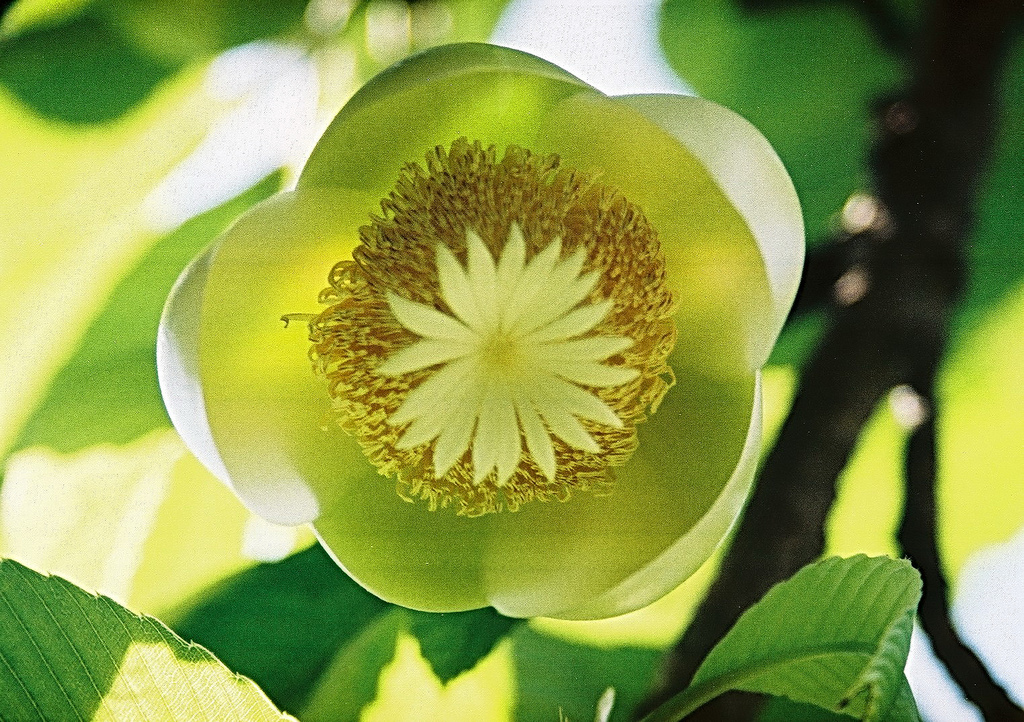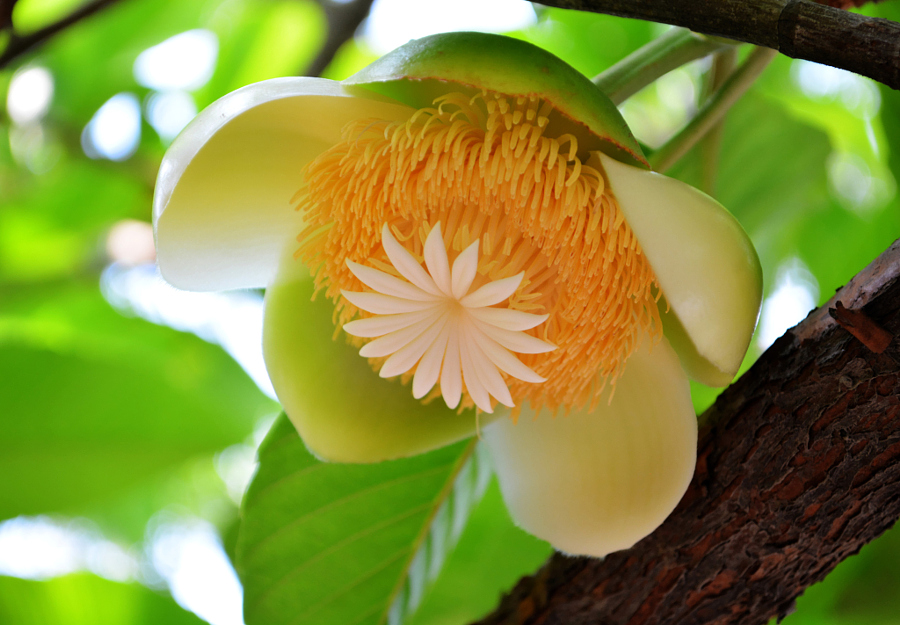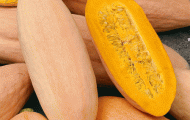Dilleniaceae (Dillenia family)
Green globose fruits are formed by an aggregate of 15 overlapping carpels, each containing 5 seeds embedded in an edible, gelatinous pulp.
Description. Medium-sized evergreen tree, 10-15 m (33-50 ft) tall, with smooth, brown bark and spreading branches. Alternate, simple leaves oblong to elliptic, 25-35 cm (10-14 in) long by 12-20 cm (5-8 in) wide. Blades shiny green with serrated margins and corrugated surface with impressed veins. Large, showy, solitary white flowers with 5 fleshy petals and several yellow stamens and white pistils. Green globose fruits, 10-15 cm (4-6 in) in diameter, are formed by an aggregate of 15 overlapping carpels, each containing 5 seeds embedded in an edible, gelatinous pulp. Fully ripe fruits are yellowish-brown in color and have a sour to sweet-sour taste.
Origin and Distribution. Native in a range from India and Sri Lanka to Southeast Asia and north to Vietnam and southwestern China. Often planted as an attractive ornamental. Rarely grown outside its natural range.
Food uses. Especially in India the pulp of the fruit is used to make jams, fruit drinks, and vinegar. Underripe fruits are pickled or used in the preparation of savory dishes like curries and soups. The fleshy petals of the flower are added as a colorful ingredient to fruit and vegetable salads or cooked and eaten as a vegetable.
Comments. The fruits of several Dillenia species such as D. pentagyna and D. aurea are edible and used like the elephant apple. D. suffruticosa, locally called simpoh ayer, is a closely related species (with shrubby growth and large yellow flowers) native to tropical Southeast Asia. The tender young leaves of this tree are used in green salads.
The genus is named after the German botanist and professor Johann Jacob Dillenius (1687-1747), who published numerous botanical papers and is known for his botanical illustrations.
The fruit is also known as dragon’s eye, because the open fruit resembles an eyeball.
Description. Small evergreen tree with a dense rounded crown, 8-10 m (26-33 ft) tall. Alternate, paripinnate leaves with 6-10 elliptic to lanceolate leaflets 12-18 cm (5-7 in) long. Pale yellow flowers are produced in erect terminal panicles. Globose fruits, 1.5-2.5 cm (0.6-1 in) wide, have brittle yellowish-brown skin and a soft, translucent, juicy flesh containing a single shiny black seed.
Origin and Distribution. Native to southern China and northern Myanmar, where the tree grows naturally in warm, subtropical lowlands and premontane forests. The longan can withstand light frosts but is not resistant to drought. It is widely cultivated in Asia and to a much lesser extent also in subtropical and tropical regions of Africa and the Americas as a fruit tree and also as an ornamental and shade tree.
Food uses. Ripe fruits, which have a sweet but less aromatic taste than the related lychee (Litchi chinensis, p. 139), are predominantly consumed fresh. The translucent flesh is used in fruit salads and desserts as well as in savory recipes like sweet-and-sour dishes and stir-fries. Fruits are preserved by canning in syrup or drying. Dried fruits, which have a leathery texture and turn blackish, are used to make refreshing drinks and aromatized teas. The seeded fruits are macerated in alcohol to produce a type of liqueur.
Comments. The fruit is also known as dragon’s eye, because the opened fruit with its whitish, translucent flesh and shiny black central seed closely resembles an eyeball.
The longan is widely used in Chinese herbal medicine as a febrifuge and vermifuge and is regarded as an antidote for poison.
With its beautiful, aromatic foliage, this attractive tree is often grown as an ornamental
Description. Erect evergreen tree with a pyramidal growth habit, 20-35 m (66-115 ft) tall. Alternate leaves very aromatic, oblong, glossy, 15-23 cm (6-9 in) long with pointed apex and silvery underside. Waxy white clustered male and solitary female flowers are borne on separate trees. Fruits oblate, 5-10 cm (2-4 in) in diameter with thin orange, brown, yellow, or purple-red skin densely covered in short, golden brown hairs. Pulp whitish, soft, mealy, with a taste reminiscent of an apple-banana blend.
Origin and Distribution. Native to the Philippines. With its beautiful, aromatic foliage, this attractive tree is grown in tropical Asia as a fruit tree, as a shade tree, and very often as an ornamental. Occasionally grown in Africa or America. The tree requires a humid tropical climate.
Food uses. Ripe fruits are eaten fresh. The flesh is often sprinkled with lime juice and eaten as dessert or served in fruit salads. Fruits are also fried or boiled and used as an ingredient in savory meat dishes and soups. Overripe fruits emit an unpleasant odor like rotten cheese. Before being eaten, these fruits must be peeled and chilled for a few hours to dissipate the odor.
Comments. Mabolo is considered a fairly good source of iron and calcium and a good source of vitamin B. A decoction of the bark is used in traditional Philippine herbal medicine to treat skin problems and cough.
Description. Evergreen tree, 20-25 m (66-82 ft) tall with very dark bark. Elliptic leaves alternate, leathery, 12-30 cm (5-12 in) long, glossy. Flowers, borne singly or in small clusters in axils of leaves, are tubular, white with a sweet scent and a green calyx. Green or yellowish-green fruits round or oblate, 8-14 cm (3-5.5 in) wide with persisting 4-lobed calyx. Pulp dark brown to black, soft, almost jamlike with a sweet aroma. Fruits contain 1-10 brown seeds 1.5-2 cm (0.4-0.8 in) long.
Origin and Distribution. Native to the tropical lowlands of Central America and Southern Mexico. After their arrival in Central America, the Spaniards took seeds of the tree to their Asian colonies. It is now cultivated in the Philippines and on a small scale in many other tropical countries but never gained much popularity outside of Mexico.
Food uses. The seeded pulp, which has a puddinglike consistence and a sweet, somewhat peachlike taste, is eaten mainly as dessert. In Mexico, the pulp of the black sapote is mashed and mixed with wine or rum, cinnamon, and sugar and served as a dessert called dulce de zapote. It is also made into ice cream and marmalade. In the Philippines, the fruits are eaten with orange juice or milk. The pulp can be used for pie filling and cakes and is sometimes blended with pineapple juice for a fruit drink.
Comments. The fruits are rich in minerals and vitamin C, containing about twice as much ascorbic acid as an orange. The wood is used for making furniture and tool handles. The common name of black sapote is often confused with plants like sapote (Pouteria sapota, p. 196), in the family Sapotaceae, and white sapote (Casimiroa edulis), in the family Rutaceae.
Benefits Of: ELEPHANT APPLE Photo Gallery
Maybe You Like Them Too
- 5 Korean Hair Care Products To Try
- How to Remove Black Hair Dye and Restore Your Color
- Refusing To Camouflage Gray Hair At Work Reddit
- How To Stop Shampooing And Washing Hair Every Day
- How To Get Rid Of Oily Hair

